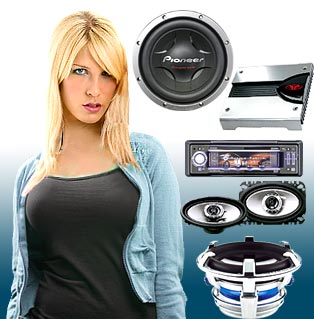| Chennai India | Transport | Chennai Real Estate | Home Issues | Education | Destination | Recreation | Chennai Hotels | Cars in India |
|
Cars in India
New Cars in India
Diesel vs Petrol Cars
Improve Your Car Mileage
Car Loans India
Used Car Buying Tips
Entry level Cars in India
Mid Segment Cars in India
Luxury Cars in India
Indian SUV
Bikes in Chennai India
Maruti Cars in India
Volkswagen Cars in India
Hyundai Cars in India
Honda Cars in India
Tata Cars in India
Toyota Cars in India
Custom Wheels Car Alarm Car Stereo Amplifiers Car Navigation Visual System Auto Dimming Mirror Maruti Car security iCAT Car Security System Car Spoiler Bumper Guard Car Seat Covers |
The most common basic audio entertainment is the Radio/tape player units with about 10 W per channel built in amplifier. Many come with CD players and CD changers too which go under the name of Head Units. But most people these days sport small handheld MP3 players or Ipods which can hold one GB or more of storage capacity. As a result of the popularity of these MP3 players, the current crop of head units contain USB ports to mate with these audio units. Some even come equipped with WiFi and bluetooth for added connectivity. Power Amplifiers: Typically most car units will provide 50 W (rms) per channel. With four channels (2 sets of identical Stereo) a head unit is capable of providing a peak output of around 400 W (combined peak music power output) into the rated 2 Ohm speaker load. Power Output: Power output is measured in Watts. Other things being equal the more power you deliver to the speakers, the more sound energy you get to hear. But our human ears are not designed to hear all frequencies equally and at all ages. When you are young, you hear frequencies from about 20 Hz to about 20 KHz and as you age, the higher frequencies fade off inside your ears. Again the thumping bass frequencies which give "body" to any music is probably felt by your body too. Bass frequencies require higher power too and woofers - the speakers dedicated to reproduce the lower sound, need the maximum power too. Some manufacturers quote a high figure of wattage using Peak Music Power Output (PMPO) - about 4 times the RMS (root mean Square - the true value of power output) value. Most amplifiers use bridge mode configuration to supply the maximum power with the normal 12 V supply available in a car. Some very high powered amplifiers to drive subwoofers use Switch Mode Power Supply Units to increase the available power supply. Most amplifiers driving Sub woofers will be rated at least 300 W rms (1200 W peak music power).
Signal to noise Ratio: Wow and Flutter:
Car Speakers: The Power handling Capacity: The maximum power the speak can handle safely before the voice coil gets burnt out. You don't need to exceed your amplifier capacity by a large margin. Generally it would best to opt for the speakers, cross-over network and amplifiers from the same manufacturer because these components need to be matched to each other. The Sensitivity: The more the sensitivity the louder it will sound for a given input. With modern injected Polypropylene Diaphragm designs and ferrite magnet assemblies you will get typically in the regions of over 85 dB/W/m.
Frequency Range: No one size fits all frequencies. This is where speakers are classified as per their range of response - Sub Woofers: These are monster sized units which handle lots of power and need to reproduce frequencies in the region of 30 to 800 Hz. They can deliver heart thumping low frequency tucked away in any remote corner of your car. |
 |
|
|
||